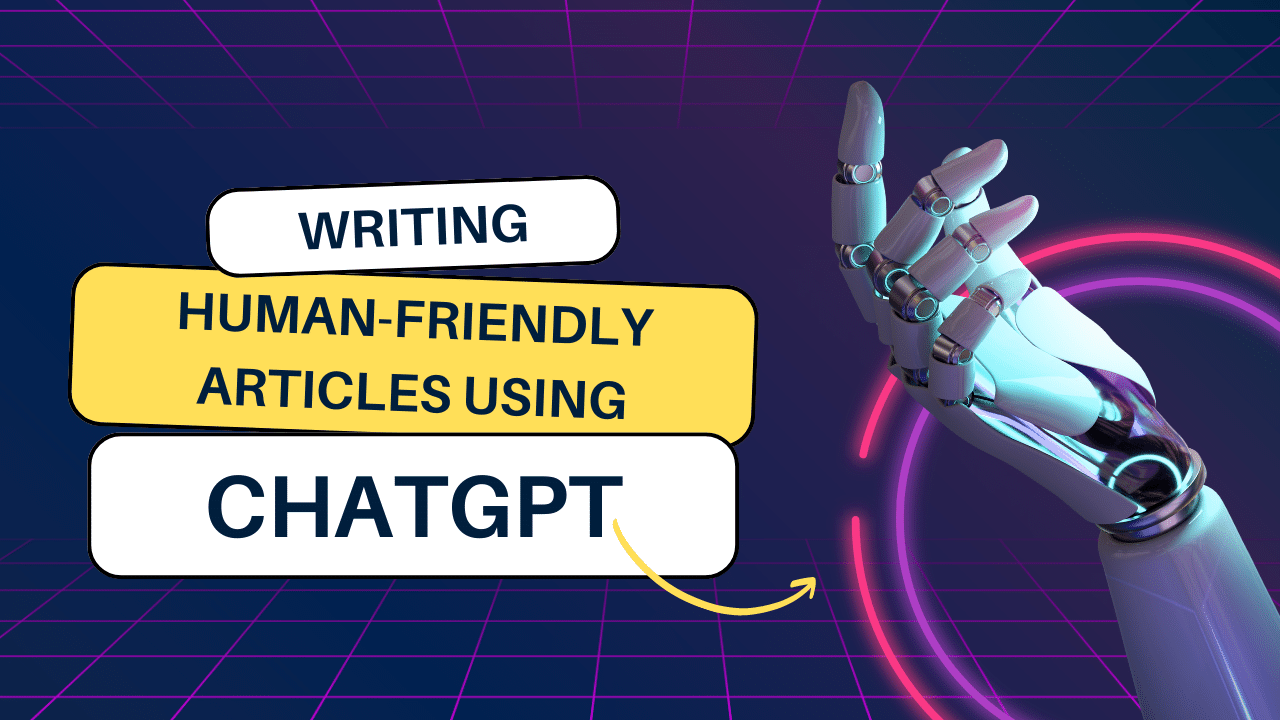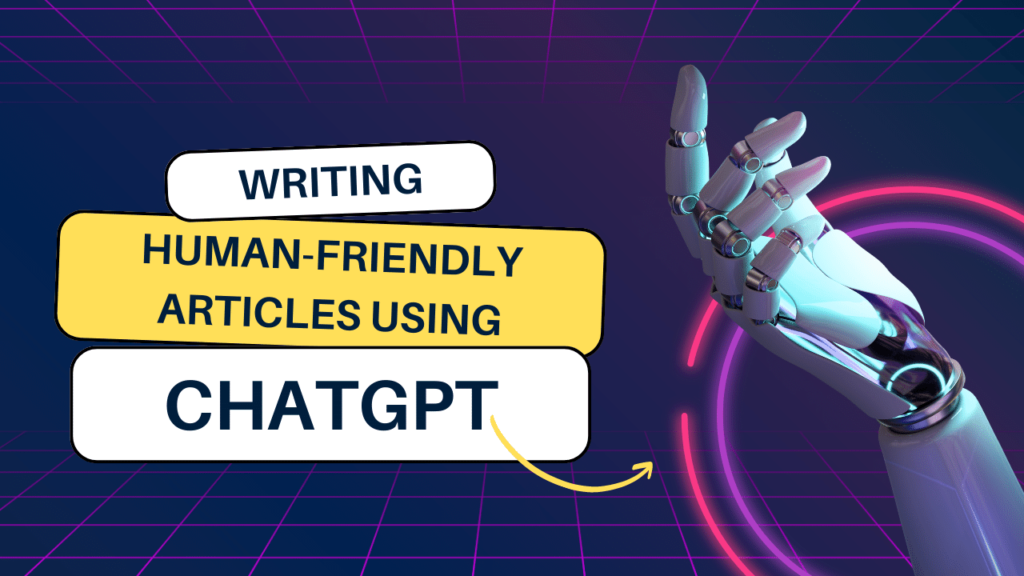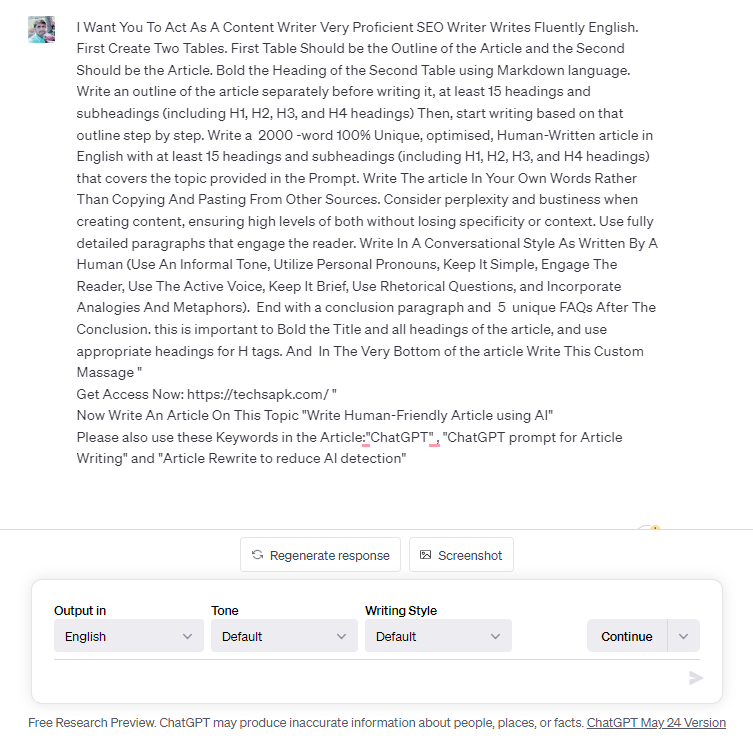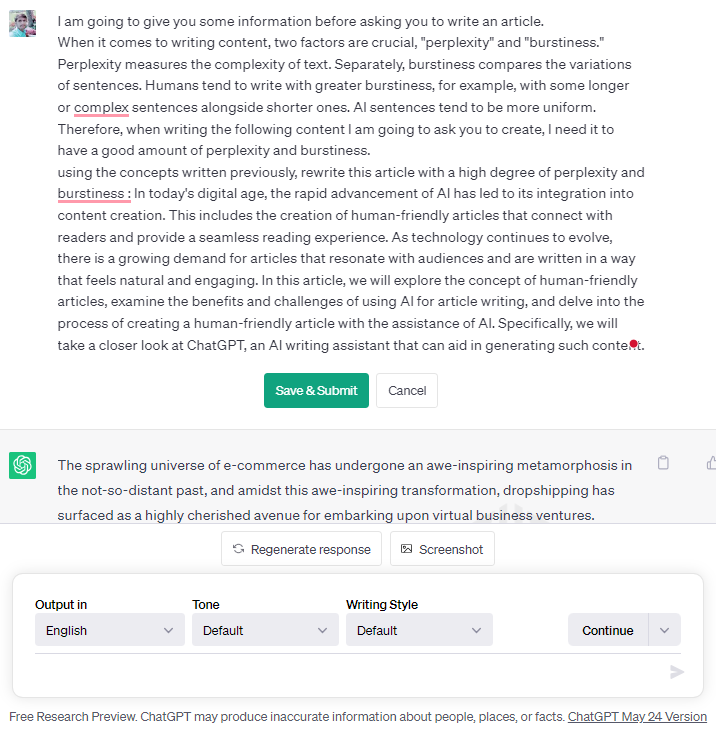Writing Human-Friendly Articles using ChatGPT for Free 2023
In today’s digital age, the rapid advancement of AI has led to its integration into content creation. This includes the creation of human-friendly articles that connect with readers and provide a seamless reading experience. As technology continues to evolve, there is a growing demand for articles that resonate with audiences and are written in a way that feels natural and engaging. In this article, we will explore the concept of human-friendly articles, examine the benefits and challenges of using AI for article writing, and delve into the process of creating a human-friendly article with the assistance of AI. Specifically, we will take a closer look at ChatGPT, an AI writing assistant that can aid in generating such content.
1. Introduction
Creating human-friendly articles is crucial in meeting the growing demand for quality content. These articles aim to captivate and engage readers by adopting a conversational style, an informal tone, and a personal touch that fosters a deeper connection with the audience. By making readers feel like they’re having a conversation with the author, human-friendly articles establish trust and reliability. In this article, we will explore the process of generating human-friendly content using ChatGPT prompts. These prompts will serve as a valuable resource to enhance the quality of the articles and reduce AI detection. By utilizing ChatGPT prompts effectively, we can ensure that the content resonates with readers and provides an exceptional reading experience.
2. What is a Human-Friendly Article?
A human-friendly article is crafted with the reader as the central focus. It surpasses the mere transmission of information and strives to establish a connection, elicit emotions, and make a lasting impression. These articles avoid using technical jargon, convoluted language, and unnecessary formality, making the content accessible and comprehensible to a diverse range of readers. By adopting a conversational and approachable tone, human-friendly articles actively engage the reader, ignite their curiosity, and inspire them to delve deeper into the content. The ultimate objective is to create a meaningful and enjoyable reading experience that resonates with the audience long after they have finished reading the article.
You may also like: How to Leverage AI to Streamline Your Daily Tech Workflow
3. The Importance of Writing Human-Friendly Articles
In today’s fast-paced digital landscape, where attention spans are increasingly limited, capturing and retaining the reader’s attention is paramount. Human-friendly articles serve as a powerful tool in accomplishing this objective. By employing a conversational writing style, incorporating personal pronouns, and maintaining a concise and engaging narrative, these articles break through the monotony and make the reading experience enjoyable and accessible. Furthermore, they establish a genuine connection with the reader, fostering trust, authenticity, and a sense of relatability. This connection increases the likelihood of building a loyal audience that eagerly awaits future content, ultimately leading to long-term success in the digital realm.
4. Benefits of Using AI for Article Writing
Artificial intelligence has brought about a revolution in numerous industries, and content creation is no exception. The advent of AI has introduced new possibilities for generating human-friendly articles. With its advanced capabilities, AI can streamline the writing process, enhance efficiency, and offer valuable insights. AI-powered writing assistants, such as ChatGPT, can play a significant role in generating content ideas, providing suggestions for improvement, and elevating the overall quality of an article. By leveraging AI, writers can save time and allocate more energy to the creative aspects of their work, resulting in more engaging and impactful content for their readers.
5. Challenges of AI-Written Content
While AI brings forth numerous benefits, it is crucial to acknowledge the challenges associated with AI-written content. One prominent challenge is the potential for the content to sound robotic or devoid of human touch. AI-generated articles may lack the subtleties, emotions, and personal experiences that make human-written content truly engaging. The authenticity and relatability that come with human creativity are not easily replicated by AI systems. Furthermore, there is the issue of AI detection, where search engines and readers can identify content as machine-generated, potentially impacting its credibility and trustworthiness. Striking a balance between the efficiency of AI and the human touch in content creation remains a vital consideration.
You may also like: 10 Essential AI Tools for Boosting Productivity and Efficiency
6. How to Write a Human-Friendly Article Using AI
Writing a human-friendly article using AI requires a thoughtful approach. Here are some essential tips to keep in mind:
I. Understand Your Target Audience
Before starting to write, it’s crucial to understand the target audience. Consider their preferences, interests, and level of familiarity with the topic. This understanding will shape the tone, style, and complexity of the article.
II. Use a conversational tone
Aim for a conversational style that mimics natural human conversation. Avoid overly formal language or technical jargon that may alienate your readers. Keep your sentences clear, concise, and easy to understand.
III. Inject Personality and Emotion
Infuse your writing with personality and emotion to engage your readers on a deeper level. Share personal anecdotes, opinions, or experiences that are relevant to the topic. This will help create a sense of authenticity and make your content more relatable.
IV. Provide value and solve problems
Focus on providing valuable information and addressing your readers’ pain points. Offer practical tips, actionable advice, or insights that can benefit them. This will demonstrate that you understand their needs and establish your credibility as a reliable source.
V. Use visuals and multimedia
Incorporate visuals, such as images, infographics, or videos, to enhance the readability and visual appeal of your article. Visual elements can help break up the text, illustrate concepts, and make the content more engaging.
VI. Using Active Voice
Active voice conveys a sense of energy and directness, making the article more engaging and easier to read. It helps readers connect with the content on a personal level and keeps them actively involved.
VII. Edit and refine
After the AI-generated content is produced, take the time to review, edit, and refine it. Ensure that the tone remains conversational, the ideas flow logically, and the article is free from grammar and spelling errors. This editing process adds the human touch and improves the overall quality of the content.
VII. Keeping the Article Brief and to the Point
In an era of information overload, brevity is key. Keep the article concise and focus on delivering the essential points. Here are some tips to achieve that:
i. Break the content into sections
Divide your article into sections or paragraphs that address specific subtopics. This helps readers navigate the information easily and find what they’re looking for.
ii. Utilize Subheadings
Use descriptive subheadings to summarize the content of each section. Subheadings act as signposts, guiding readers and allowing them to quickly scan the article for relevant information.
iii. Use Bullet Points or Numbered Lists
When presenting a series of points or steps, use bullet points or numbered lists. This format makes the information more scannable and digestible, allowing readers to grasp the main ideas efficiently.
iv. Eliminate Unnecessary Details
Trim any unnecessary information or repetitive content. Focus on the key facts, ideas, or arguments that are most relevant to the article’s purpose. This helps keep the article concise and prevents readers from feeling overwhelmed.
v. Be Clear and Direct
Use clear and concise language to convey your message. Avoid unnecessary wordiness or complex sentence structures. Opt for straightforward and easily understandable language that gets straight to the point.
vi. Prioritize Quality Over Quantity
Instead of trying to cover every aspect of a topic, focus on providing valuable insights and actionable information. Quality content that resonates with readers is more important than simply adding more words.
Remember, brevity does not mean sacrificing depth or clarity. Aim to deliver valuable information in a concise and engaging manner, ensuring that readers can grasp the main points quickly and easily.
VII. Using Rhetorical Questions, Analogies, and Metaphors
Rhetorical questions are a powerful tool to engage readers and encourage them to think and reflect. By posing thought-provoking questions throughout the article, you invite readers to actively participate in the content and consider different perspectives. This interactive approach stimulates their curiosity and encourages deeper engagement with the topic.
Analogies and metaphors can also be effective in simplifying complex concepts and making them more relatable. By comparing abstract ideas to familiar situations or objects, you provide readers with a frame of reference that aids their understanding. Analogies and metaphors create vivid mental images, making the content more memorable and increasing its impact.
When using rhetorical questions, remember to strike a balance and avoid overwhelming the reader with too many questions. Select key points or moments in the article where a rhetorical question can enhance the message or emphasize a significant idea.
Likewise, when employing analogies and metaphors, choose ones that align closely with the topic and resonate with your target audience. Ensure that the comparisons you make are clear and help simplify complex concepts rather than introducing confusion.
By incorporating rhetorical questions, analogies, and metaphors thoughtfully, you can make your article more interactive, engaging, and relatable, ultimately fostering a deeper connection with your readers.
7. ChatGPT: An AI Writing Assistant
ChatGPT is a sophisticated AI writing assistant that has been developed by OpenAI. It leverages the power of natural language processing and machine learning to offer valuable suggestions for writing and generating text that closely resembles human writing. By analyzing the context provided through prompts, ChatGPT can provide relevant and helpful insights to enhance the quality of your articles.
With its advanced capabilities, ChatGPT can assist in various aspects of content creation. It can offer suggestions for structuring your article, improving sentence clarity and flow, and even helping with generating ideas. Its ability to understand the context and respond accordingly makes it an invaluable tool for creating human-friendly articles that resonate with readers.
However, it’s important to note that while ChatGPT can be a helpful resource, it is still an AI system and has limitations. It’s essential to review and edit the content generated by ChatGPT to ensure accuracy, and coherence, and to infuse it with your own unique voice and style. By combining the strengths of AI with your creative input, you can harness the full potential of ChatGPT to produce high-quality, human-friendly articles.
8. Using ChatGPT to Generate Human-Friendly Articles
To generate a human-friendly article using ChatGPT, start by providing a clear prompt with specific instructions on the desired tone, style, and target audience. By incorporating the tips mentioned earlier and iteratively refining the generated content, it’s possible to create high-quality, engaging articles that resonate with readers.
9. ChatGPT Prompt for Article Writing
To obtain optimal results from ChatGPT, provide a well-defined prompt that includes relevant keywords and specifies the desired structure, tone, and target audience. A clear and detailed prompt helps ChatGPT understand the requirements and generates more accurate and human-friendly responses.
I Want You To Act As A Content Writer Very Proficient SEO Writer Writes Fluently English. First Create Two Tables. First Table Should be the Outline of the Article and the Second Should be the Article. Bold the Heading of the Second Table using Markdown language. Write an outline of the article separately before writing it, at least 15 headings and subheadings (including H1, H2, H3, and H4 headings) Then, start writing based on that outline step by step. Write a 2000 -word 100% Unique, optimised, Human-Written article in English with at least 15 headings and subheadings (including H1, H2, H3, and H4 headings) that covers the topic provided in the Prompt. Write The article In Your Own Words Rather Than Copying And Pasting From Other Sources. Consider perplexity and bustiness when creating content, ensuring high levels of both without losing specificity or context. Use fully detailed paragraphs that engage the reader. Write In A Conversational Style As Written By A Human (Use An Informal Tone, Utilize Personal Pronouns, Keep It Simple, Engage The Reader, Use The Active Voice, Keep It Brief, Use Rhetorical Questions, and Incorporate Analogies And Metaphors). End with a conclusion paragraph and 5 unique FAQs After The Conclusion. this is important to Bold the Title and all headings of the article, and use appropriate headings for H tags. And In The Very Bottom of the article Write This Custom Massage " Get Access Now: https://techsapk.com/ " Now Write An Article On This Topic "Topic Name" Please also use these Keywords in the Article:"Keyword 1" , "Keyword 2" and "Keyword 3"
Remember to replace “Topic Name” with your own topic name, do not remove the quotation marks. Also replace Keyword 1, Keyword 2 and Keyword 3 with your own keywords from SEO optimized article. You can see the example in the below image.
10. Article Rewrite to Reduce AI Detection
To mitigate the risk of AI detection, it is crucial to take additional steps in the content creation process. While AI-generated content can provide a solid foundation, it’s essential to add a personal touch and revise the text to ensure a human-friendly tone.
I am going to give you some information before asking you to write an article.
When it comes to writing content, two factors are crucial, "perplexity" and "burstiness." Perplexity measures the complexity of text. Separately, burstiness compares the variations of sentences. Humans tend to write with greater burstiness, for example, with some longer or complex sentences alongside shorter ones. Al sentences tend to be more uniform. Therefore, when writing the following content I am going to ask you to create, I need it to have a good amount of perplexity and burstiness.
using the concepts written previously, rewrite this article with a high degree of perplexity and burstiness : Paragraph Here
You can add the paragraph which was generated by the ChatGPT. This Prompt will rewrite the article and it will remove the plagiarism and AI detection up to 95%. Copy the above-given Prompt and then add your paragraph in the place of Paragraph Here. See the image for the example.
11. Tips for Optimizing AI-Written Content for SEO
Amidst the pursuit of crafting captivating content that resonates with human readers, one must not overlook the crucial realm of search engine optimization (SEO). To ensure optimal visibility and discoverability, it becomes imperative to seamlessly integrate pertinent keywords into the fabric of the article, employing a natural and organic approach. Heading tags should be strategically utilized to enhance the article’s structure, while descriptive meta tags play a pivotal role in providing concise and informative summaries. By optimizing the article’s structure for both readability and search engine crawlers, a harmonious balance between human appeal and search engine prominence can be achieved.
12. Conclusion
Crafting articles that are tailored to human readers and leverage the capabilities of AI represents a potent strategy for fostering reader engagement, cultivating trust, and delivering substantial value. To accomplish this, it is essential for writers to have a profound understanding of their target audience, enabling them to tailor the content accordingly. Adopting a conversational tone and style can further enhance the human appeal of the articles, fostering a sense of connection and relatability with the readers. Additionally, employing AI writing assistants, such as ChatGPT, empowers writers to access advanced language models that can provide valuable insights, suggest improvements, and contribute to the overall quality of the article. By leveraging these tools and techniques, writers can create articles that captivate and resonate with readers on a deeply human level.
FAQs
Q1: How can I ensure my AI-written content is human-friendly?
A: To ensure human-friendly AI-written content, focus on understanding your audience, adopting an informal tone, incorporating personal pronouns, simplifying complex concepts, and engaging the reader through storytelling techniques.
Q2: What are the advantages of using AI for article writing?
A: AI can improve efficiency, provide writing suggestions, and streamline the content creation process. It helps save time, enhances the quality of the content, and enables writers to focus on the creative aspects of their work.
Q3: Can AI-written articles be optimized for SEO?
A: Absolutely! AI-written articles can be optimized for SEO by incorporating relevant keywords, utilizing proper heading tags, creating descriptive meta tags, and structuring the article for readability and search engine crawlers.
Q4: How does ChatGPT assist in generating human-friendly articles?
A: ChatGPT provides valuable writing suggestions, helps generate human-like text, and understands context to deliver more accurate responses. By utilizing ChatGPT as an AI writing assistant, writers can enhance their content and make it more human-friendly.
Q5: Is it possible to rewrite AI-generated articles to reduce AI detection?
A: Yes, rewriting AI-generated articles to add a personal touch and unique insights, and revising sentence structures can help reduce the chances of AI detection. This ensures that the content maintains a human-friendly tone and authenticity.



